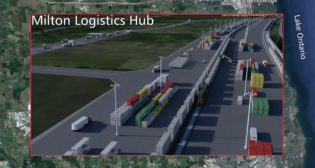
AAR: Freight traffic slump continues
Written by William C. Vantuono, Editor-in-ChiefFor April 2016, combined U.S. carload and intermodal originations were 1,972,829, down 11.8% or 264,327 carloads and intermodal units from April 2015, reported the Association of American Railroads on May 4, 2016. Carload traffic in April totaled 944,339 carloads, down 16.1% or 180,598 from April 2015. U.S. railroads also originated 1,028,460 containers and trailers in April 2016, down 7.5% or 83,729 units from the same month last year.
In April 2016, five of the 20 carload commodity categories tracked by the AAR each month saw carload gains compared with April 2015. These included: miscellaneous carloads, up 25% or 4,743 carloads; coke, up 16.1% or 2.354 carloads; and chemicals, up 1.5% or 1,909 carloads. Commodities that saw declines in April 2016 from April 2015 included: coal, down 39.7% or 160,624 carloads; petroleum and petroleum products, down 25.1% or 15,122 carloads; and grain mill products, down 7.1% or 2,760 carloads.
Excluding coal, carloads were down 2.8% or 19,974 carloads from April 2015.
Total U.S. carload traffic for the first 17 weeks of 2016 was 4,087,620 carloads, down 14.3% or 83,729 carloads, while intermodal containers and trailers were 4,368,132 units, down 0.8% or 33,771 containers and trailers when compared to the same period in 2015. For the first four months of 2016, total rail traffic volume in the United States was 8,455,752 carloads and intermodal units, down 7.8% or 715,985 carloads and intermodal units from the same point last year.
For the week ending April 30, 2016, total U.S. weekly rail traffic was 502,045 carloads and intermodal units, down 11.3% compared with the same week last year, reported the Association of American Railroads on May 4, 2016.
Total carloads for the week ending April 30 were 243,604 carloads, down 14.1% compared with the same week in 2015, while U.S. weekly intermodal volume was 258,441 containers and trailers, down 8.6% compared to 2015.
Five of the 10 carload commodity groups posted an increase compared with the same week in 2015. They included miscellaneous carloads, up 12.7% to 10,204 carloads; grain, up 8.7% to 20,038 carloads; and motor vehicles and parts, up 3.1% to 18,965 carloads. Commodity groups that posted decreases compared with the same week in 2015 included coal, down 37% to 64,145 carloads; petroleum and petroleum products, down 25.5% to 11,053 carloads; and forest products, down 13.1% to 10,025 carloads. North American rail volume for the week ending Apr. 30, 2016, on 13 reporting U.S., Canadian and Mexican railroads totaled 331,394 carloads, down 12.8% compared with the same week last year, and 330,622 intermodal units, down 7.3% compared with last year. Total combined weekly rail traffic in North America was 662,016 carloads and intermodal units, down 10.1%. North American rail volume for the first 17 weeks of 2016 was 11,095,263 carloads and intermodal units, down 7.3% compared with 2015.
Canadian railroads reported 71,400 carloads for the week, down 11.3%, and 60,413 intermodal units, down 4.7% compared with the same week in 2015. For the first 17 weeks of 2016, Canadian railroads reported cumulative rail traffic volume of 2,187,859 carloads, containers and trailers, down 6.6%.
Mexican railroads reported 16,390 carloads for the week, up 3.2% compared with the same week last year, and 11,768 intermodal units, up 9.8%. Cumulative volume on Mexican railroads for the first 17 weeks of 2016 was 451,652 carloads and intermodal containers and trailers, down 0.2% from the same point last year.
“Rail coal traffic continues to suffer due to low natural gas prices and high coal stockpiles at power plants. Coal accounted for just 26% of non-intermodal rail traffic for U.S. railroads in April 2016, down from 36% in April 2015 and 45% as recently as late 2011,” said AAR Senior Vice President of Policy and Economics John T. Gray. “We expect non-coal carloads to strengthen when the economy gets stronger, and we think intermodal weakness in April is probably at least partly a function of high business inventories that need to be drawn down before new orders, and thus new shipments, are made.”



